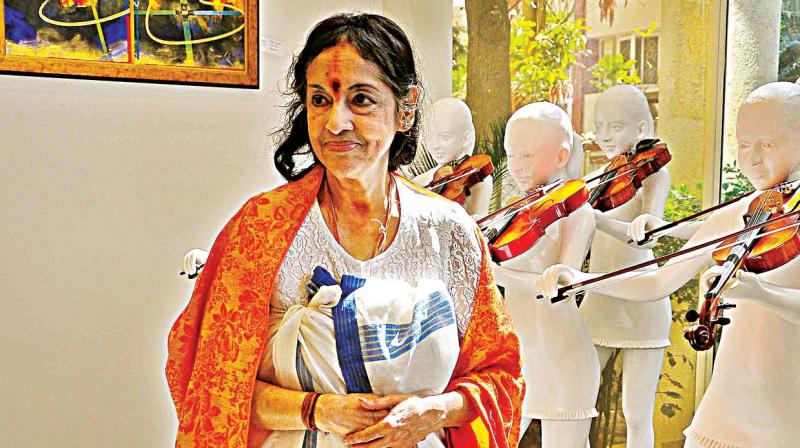The varma legacy: Burnished by pain and solitude

Born into Kerala’s royal family of Travancore and the descendant of one of the greatest artists of our time, Rukmini Varma retreated into complete solitude when she lost her son in 1981. Over thirty years later, she has re-emerged for a solo show, titled Opulence & Eternity. She talks to Darshana Ramdev about art, rebellion, loss, her years of reclusivity and the forces that inspired her to return.
“You're looking at a ghost." This is Rukmini Varma’s opening line, delivered quietly and with a smile. The great-granddaughter of Raja Ravi Varma, the celebrated 19th century artist and a member of the royal family of Travancore, Rukmini Varma represents a great legacy, one of the finest, perhaps, in Indian history.
She sits at Gallery G on Lavelle Road on Friday afternoon, shortly before her first show in 32 years - Opulence & Eternity is a series of paintings she began back in the 1980s, which lay unfinished until very recently. This is a turning point in her life - Rukmini Varma has re-emerged after nearly three decades of solitude, which began with the death her son in 1981.
Overwhelmed, maybe even a little nervous, but resolute, Varma has made her way back into the world once more. “I never thought I would return,” she said. During this time, she never left her house, not even to take a walk in the garden. “I had my life inside - my parents needed looking after as well. I would meditate, pray and spend my time painting.” She didn’t think these works would see the light of day, to her, the process of painting had become deeply spiritual.
When Gitanjali Maini set up the Raja Ravi Varma Foundation in 2007, it was arranged that the meetings would take place in Varma’s home in Bengaluru. “I never went out, so they came to me,” she said. Gitanjali, to whom she refers with great affection as ‘Gita’, saw the paintings lying around her house. “Many of the canvases were unfinished - I had started them before I lost my son and I didn’t have the strength to finish them.”
After much coaxing, Varma decided the time had come and set about touching up the unfinished canvases. “I have always been drawn to the human figure, to skin tones — but the concept of the paintings had changed,” she explained. “Maybe it is my great grandfather reaching out to me through her,” she says, her eyes lighting up in a sudden instance of realisation. “
Rukmini Varma was born in 1940, the great-granddaughter of the last Maharani of Travancore. Her birth was widely celebrated — as befits the advent of a princess. She spent her childhood in Satelmond Palace in Trivandrum, where she fell completely in love with the arts, studying painting, music and dance from the best teachers in the country. “There were always restrictions, though,” she said. “There are restrictions in life no matter what.”
One thing was for certain, made evident during the 1981 show at Jehangir National Gallery, which caused a stampede for depicting scantily-clad Indian goddesses. Rukmini Varma was a rebel. “I wanted to be a dancer and performed publicly a couple of times, but it didn’t go down too well with the family. My place in life was to marry and produce heirs.” She married and moved to Bengaluru, where she started a very successful dance school. “All this was my time of rebellion,” she said.
The real Rukmini — the world she understood best — lay far beneath even these acts of rebellion. Her love for the arts – she is a trained dancer, an accomplished artist, a sculptor and a writer – served as mediums for an extraordinary creative force. “I have always had visions – visitations, I call them. It’s a character defect,” she adds, laughing. “They found their way out through my art – that’s why I studied so many forms. I needed them.” A trunk of manuscripts lies unopened in her house even now, she said.
I have always had two distinct worlds - the one without and the one within,” she said. “Maybe everybody does, but they’re able to connect the two. I know I can’t. I understand my own reality better than that of the world.” Is she happy with her decision to return to the ‘real’ world? Perhaps its too soon to tell, perhaps the answer will never be clear. “Gita told me that my life of solitude wasn’t benefiting anybody, including myself,” Varma said. “She helped me come to terms with my past, which is something I had tried to hide from, to bury. I have learned that art transcends time and circumstance.”
It is, no doubt, hugely unfair to reduce a lifetime of experience to a single, cohesive lesson. Varma doesn’t attempt to do this either, simply saying, “Life is a process. You find your answers when you’re ready for them. I retreated from the world because I needed to and I’m back because it is the time. Maybe there is an ultimate final phase of human existence, but getting there is a process. You can’t skip a step.”

